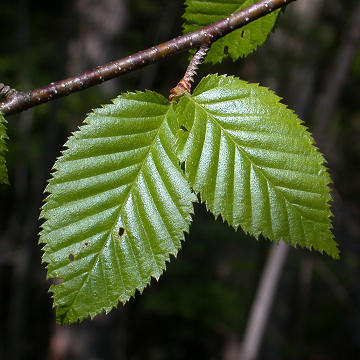

Betula allegheniensis - (image 1 of 5)
Taxonomy
Family: Betulaceae
Habitat
Frequently with hemlock, maple, and beech.
Associates
Moist, well-drained forest soils. This requirement for good drainage seems to be the consensus, although I have seen this tree growing on small hummocks in swamps - perhaps the roots are confined to the upper portion of the hummock.
Distribution
Newfoundland west to southeast Manitoba, south to DE, OH, northern IN, WI, MN, and parts of IA, and in mountains to GA.
Morphology
Medium to large-sized tree with an irregular crown. Leaves lance-ovate to ovate with a coarsely serrate margin, short acuminate, rounded or subcordate at the base, glabrous above and pubescent on the veins below; often in pairs on spur branches. Twigs slender, smooth, bronze-gray, with lenticels; fragrance of wintergreen when scratched; buds ovoid, sharply pointed, reddish brown with ciliate margins to the scales. Bark somewhat shiny, yellow-bronze when young, soon becoming yellow-gray and papery; bark of old trees dark and roughened. Staminate aments (catkins) pendent, at the end of twigs. Fruit an ovoid to short-cylindric ament, to 2-3 cm long, upright.
Notes
Flowers mid April to mid May
Wetland Indicator: Facultative
Important hardwood lumber tree. Fall color is yellow. Used as a flavoring for Birch Beer. Twigs and leaves can be used to make tea. Can form stilt-like roots, enabling it to establish on rocky hillsides. A sapling can develop in a crevice in a rock and then establish a root system around the rock for support.
References
Gleason, Henry A.
and A. Cronquist. 1991. Manual of Vascular Plants of Northeastern United States
and Adjacent Canada. Second Ed.
The New York Botanical Garden. Bronx, NY
Peterson, L. A. 1977. A Field Guide to Edible Wild Plants: Eastern and central North America.
Houghton Mifflin Company. New York, NY
Swink, F. and G.
Wilhelm. 1994. Plants of the Chicago Region.
Indiana Academy of Science. The Morton Arboretum. Lisle, Illinois.
USDA, NRCS. 2002.
The PLANTS Database, Version 3.5 (http://plants.usda.gov).
National Plant Data Center, Baton Rouge, LA 70874-4490 USA
|
© Michael Hough 2004 |